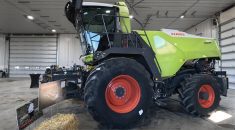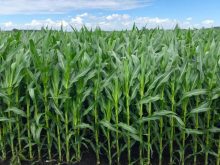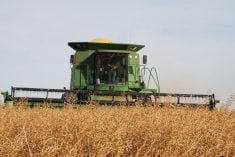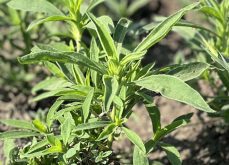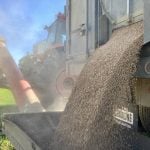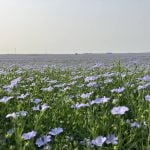Western Canadian scientists conducting research into field crop pests can always use more help from producers.
Farmers don’t get directly paid for this help, but being involved in the process to monitor crop diseases, weeds and insect pests becomes integral to the work of researchers producing accurate maps, pest-severity forecasts, and potential treatment and management options. The hope is that all this information comes together to help farmers to better protect their crops.
Farmers and landowners can help researchers in a couple of different ways, says Brent McCallum, a plant pathologist at the Agriculture and Agri-Food Canada (AAFC) Research Centre at Morden, Man. He specializes in wheat leaf rust disease and chairs a relatively new initiative, the Prairie Biovigilance Network (see sidebar below).
Read Also

Claas brings 1000 Series SP forage harvesters to Canada
In mid-August, Claas unveiled its new line of Jaguar forage harvesters at an event in Visalia, California, deep in the heart of that state’s dairy region.
Allow access
One important area where farmers can help is to allow access to their land, McCallum says. Farmers make it known through their agronomist, provincial ag rep or commodity organization that researchers and technicians can visit fields to check for pests, whether it be weeds, insects or diseases.
This doesn’t mean hordes of people will be trampling or driving over standing crops, he says. It usually involves one person walking into a field from the road, wearing phytosanitary boot covers and making a quick inspection on random fields. Whoever makes the inspection always calls and double-checks with the producer before they come.
Boots on the ground
The other important area where farmers can help is to provide researchers with information on what they see in the fields. Their reports on crop disease symptoms, new or suspicious weeds and insect activity all help to complete the crop pest severity picture.
“It is all totally voluntary,” says McCallum. “But farmers are the front-line people and as researchers we are always interested in what they are seeing in their fields.” They may be able to submit photos, collect and submit samples, or just provide a report on crops or a pest situation.
All information collected goes into a database to produce maps showing distribution of each crop pest, helps researchers determine the severity of a given pest, and contributes to recommendations on treatment or management of a particular disease, insect or weed.
Producers helping researchers isn’t a new idea by any means, McCallum says. Farmers, landowners and others from non-scientific communities have been providing feedback to agriculture researchers for more than 100 years.
Saskatchewan Agriculture, for example, has a long-running program where farmers can sign up to be Crop Reporters — essentially reporting on crop conditions. More recently the department created a service where farmers can sign up to help with pest monitoring. Farmers interested in making their fields available for monitoring in that province can get more information here.
“Farmer involvement continues to be important in helping to monitor and measure pest conditions, assess the risk and then develop recommendations for treatment and management,” says McCallum.
Voluntary and confidential
Some key points for producers interested in making their land or themselves available to collect information on crop pests:
- It is totally voluntary.
- If a farmer does make their fields available to random inspections, the researcher or technician making the inspection will call ahead of the visit to confirm.
- All information is totally confidential and farmer identity is protected. If there is a disease, insect or particular weed identified, it will be mapped or go into the database as being within a region or municipality with no connection to a particular farm.
- Often the researcher is able to provide the producer a confidential report of what they do find in the fields, for their own use.
“There are hundreds of farmers across Western Canada who open their fields and provide information to researchers, now,” McCallum says. “But in some respects it is getting more difficult to connect with producers.”
For example, “farmers get a bit leery in providing information to someone, concerned that down the road they may have to pay for some tool or service. And with an increase in rural crime in recent years, farmers are concerned about trespassers and who has access to their land, and there are also privacy concerns — who is going to see and how is this information to be used?”
McCallum emphasizes that visits to farm fields to assess crop pests are planned with minimal inconvenience to the producer and the producer’s right to privacy is well protected.
The information collected is valuable to the broader farming community in determining the degree of severity or risk of various pests, and is key for formulating management plans as needed, he says.
Connecting with researchers
So, how can producers connect with researchers within the Prairie Biovigilance Network? Here are three of the researchers with specialties in insect pests, weeds and crop diseases who welcome any and all producer co-operation:
Meghan Vankosky
Entomologist, AAFC Saskatoon
Researcher Meghan Vankosky, at AAFC’s Saskatoon Research and Development Centre, says having the co-operation of producers to be able to monitor fields for insect pests is essential to get a handle on pest distribution and severity.

Vankosky, co-chair of the Prairie Pest Monitoring Network, says over the past 10 years it has monitored 5,000 to 6,000 sites (fields) annually, collecting information on insects and other pests.
“With changes in provincial government trespass laws as well as changes in government policy it is becoming more difficult to access farm fields to conduct these surveys,” she says. “And every province is a bit different.
“When it comes to grasshopper surveys, for example, most of the time we conduct our sweeps in the ditches which gives us a pretty good idea of grasshopper numbers. However, for other pests we do need to check pea or canola fields, for example, and for that we need farmer permission.
“Once we have permission it is pretty straightforward; a survey only takes about five minutes. We walk into a field make our sweeps and then we are gone. But producers do need to provide permission.”
Vankosky’s research and field survey work aims to monitor seven key insect pests affecting western Canadian field crops: grasshoppers, wheat midge, wheat stem sawfly, diamondback moth, cabbage seed pod weevil, pea leaf weevil, and bertha armyworm.
Farmers willing to provide permission to have fields checked can contact Vankosky directly. They can also contact one of the provincial specialists, watch for notices on social media platforms, and in Saskatchewan can sign up online to provide pest monitoring permission. Here are those contact points:
- Prairie Pest Monitoring Network
- PPMN monitoring protocols
- Meghan Vankosky, AAFC Saskatoon
- Amanda Jorgensen, Alberta Agriculture and Irrigation
- Shelley Barkley, Alberta Agriculture and Irrigation
- James Tansey, Saskatchewan Ministry of Agriculture
- John Gavloski, Manitoba Agriculture
- Volunteer sign-up information on how to authorize access to your farmland in Saskatchewan
- The online form for the Saskatchewan program
Charles Geddes
Weed scientist, AAFC Lethbridge
Farmer involvement is also welcome as Charles Geddes, weed scientist at the Lethbridge Research and Development Centre, monitors the weed situation across Western Canada.
Geddes, who chairs the Prairie Weed Monitoring Network, encourages producers to make fields available for weed abundance surveys, which are conducted annually. He also urges farmers and agronomists to be vigilant, particularly following weed control measures, to identify plants that may be showing signs of herbicide resistance. Over the past four years the weed abundance survey has checked about 4,000 sites and another 1,600 sites have been monitored for herbicide resistance in weeds.

The weed abundance survey involves randomly selecting about 1,000 quarter sections of cropland per season across Western Canada that will be checked for weed types and population. For the herbicide resistance survey, about 200 quarter sections pre-harvest and 200 quarter sections post-harvest are checked to identify any signs of herbicide-resistant weeds.
“We select quarter sections at random and then approach the landowner for permission to check those fields to identify weed populations,” Geddes says. “It is totally voluntary and we are very respectful of producer wishes, but we’re hoping producers will allow our technicians access to survey the weed population.
“These surveys are an important part of identifying what weeds are out there and their density in any given area,” Geddes says. “That all contributes to the greater good of helping producers and the industry identify problems and management practices.”
Producer confidentiality is protected, so weed types and population data cannot be traced to any particular farm. A report on the results of a weed survey, however, will be given to the producer so they know what weeds have been identified on their land.
Along with research through the Biovigilance Network, Geddes, whose main research area is herbicide-resistant weeds, also has a couple of projects underway, relying on producer assistance, to help identify new cases of resistance.
“The first project relies on farmers and their agronomists to help identity potential cases of herbicide resistance that they see in their fields,” Geddes says. “After a burndown application, and particularly after an in-crop herbicide treatment, we are asking them to be watching while field scouting for any signs of weeds that haven’t been affected by the herbicide.”
The ideal time to do so is about three weeks after the herbicide application. “It is particularly telling if they observe weeds that have been controlled, as well as some that appear to unaffected. That is usually a good indicator of herbicide resistance.”
If herbicide resistance is suspected, Geddes encourages producers to contact him. He will send out an information kit, with the end goal of asking the producer to collect mature seeds from these unaffected plants and have those seeds submitted to Geddes for testing.
“If test results do identify herbicide resistance we can then work with that producer to develop a management plan to hopefully contain the issue before it becomes a bigger problem,” he says.
The second project related to identifying herbicide resistance in weeds, involves a new genetic test that can be made on plant tissue during the growing season, which can provide more timely results.
The testing technique, which looks for genetic markers — the genetic mechanism that confers herbicide resistance — has been proven, and Geddes is now working to identify labs across Western Canada that can provide the test. It’s hoped the test and a list of qualified labs will be available in coming months.
For background and reports from the Prairie Weed Monitoring Network, visit its website.
Kelly Turkington
Plant pathologist, AAFC Lacombe
The Prairie Crop Disease Monitoring Network (PCDMN) is being developed as a one-stop shopping site for everything producers need to know about identifying and managing cereal, oilseed and pulse crop diseases, says Kelly Turkington, a AAFC plant pathologist and chair of the PCDMN.

While the PCDMN has an excellent website launched in mid-2024, it also offers a crop disease reporting tool available for use on smartphones — first, to help farmers identify diseases in their crops, then if they so wish, with another click they can add that sighting to the larger disease map for the benefit of other producers and agronomists.
The Quick Disease Reporter Tool is available on an app. Farmers need to download the Survey 123 app (for Apple or Android) from ArcGIS, which builds interactive online maps. Next, scan a QR code for the reporter tool (it’s an app within an app).
The tool is designed to be used in the field, says Turkington, who is based at the Lacombe Research and Development Centre in central Alberta.
Once on the app, farmers looking at suspected disease symptoms can identify the crop type, suggest a specific disease, and take at least one digital picture of what they’re looking at. This can all be done without internet service.
When internet service is available, the app digitally tags the photo to the municipality, not the farmer’s field. The information is verified before a diagnosis and the municipality is added to an online map. Producers can submit the information anonymously or request a chat with a disease specialist.
“If producers chose to report a disease it doesn’t identify their farm, just the municipality, so producer confidentially is protected,” Turkington says.
“Our main message is to first of all let farmers know that the website for the disease monitoring network is available. It provides a great deal of information in terms of managing crop diseases.”
Launched in mid-2024, the PCDMN’s website provides information — text and photos — on disease identification, as well as disease risk assessment and best management practices for dealing with those diseases, Turkington says.
Key files include in-season updates, cereal rust risk, surveillance protocols and scouting tips. There’s also a free subscription option, which provides news and disease alerts directly to your email address.
Here are direct links to some of features on the PCDMN website:
- In-season updates
- PCDMN cereal rust risk reports
- Scouting protocols
- Scouting tips
- An in-season update for 2024 for the PCDMN Quick Disease Reporter Tool
- To subscribe
The scouting tips on the site include Disease Scouting Playing Cards — panels describing common cereal, oilseed and pulse crop diseases along with clear, colour photos depicting different stages of each disease.
MORE INFO: What’s the Prairie Biovigilance Network?
Brent McCallum, a researcher at Agriculture and Agri-Food Canada at Morden, Man., is leading a diverse group of experts in plant pathology, entomology, weed science, economics and agronomy in creating a network to share knowledge about the range of pests affecting Western Canadian field crops.
This collaborative effort has been dubbed the Prairie Biovigilance Network, with the goal of helping researchers and farmers quickly and holistically minimize crop losses due to weeds, disease and insects.
It’s hoped the multidisciplinary approach will help everyone better understand new agricultural farming practices, new crops and the impact of climate change on plant health and combat the negative effects of newly introduced pests.

The PBN involves researchers working together but also relies heavily on input from producers.
“We want to raise awareness and get producers participating with us,” says McCallum. “We don’t just do this work in isolation, it’s something we need to do with the producers. They’re the ones who are on the front lines and generally the first to notice pests cropping up in their fields — their contributions to the network are crucial.”
According to AAFC, “biovigilance relies on a continuous cycle of awareness, identification, assessment, and understanding … to ensure that solving one problem doesn’t lead to another.”
“The idea of the network is to break down the silos of individual pest management programs and create an integrated, holistic and collaborative approach to managing pests,” McCallum says. Hopefully the new approach will help to mitigate potential threats from plant diseases, weed species and insects before they become much bigger, more costly problems.
With the co-operation of a multi-disciplinary team of AAFC research scientists, the focus is on improving co-ordination of pest surveillance programs in Western Canada, helping producers to respond quickly and efficiently to crop pests with reduced environmental impact and fewer unintended effects.
Within the overall structure of the Prairie Biovigilance Network, there are three other networks monitoring more specific crop pests. They include the Prairie Pest Monitoring Network (insects), the Prairie Weed Monitoring Network and the Prairie Crop Disease Monitoring Network.
Along with McCallum, researchers involved in the network include Vincent Hervet, an entomologist also at AAFC Morden, specializing in insect pests affecting stored crops; Meghan Vankosky, entomologist at AAFC Saskatoon, focusing on integrated pest management of pulse and oilseed insects; Charles Geddes, at AAFC Lethbridge, a researcher in weed ecology and cropping systems, specializing in herbicide resistant weeds; and Kelly Turkington, at AAFC Lacombe, a plant pathologist focusing on diseases in cereal and oilseed crops.




